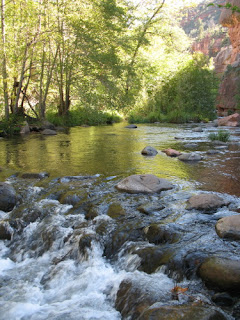Everyone’s a writer, or at
least it seems that way these days. Blogs, Facebook posts, e-newsletters,
self-published books…. I could go on, but for someone like me who’s old enough
to remember how thrilling it was to break into print (i.e., ink on actual
pages) and who’s still dreaming of writing a hardcover bestseller—well, the new
reality can be a bit disconcerting.
I feel a bit like a traveler
who suddenly realizes she’s hopelessly lost. But years of traveling have taught
me that getting lost sometimes leads to great discoveries. First, I needed to
discover—or uncover—what kind of writer I am. Or, in other words, who have I
been all these years?
I’m not an artist. Some
writers are. Terry Tempest Williams comes to mind. For me, her evocative prose
triggers a spectrum of senses and emotions, and the visual images inspired by
her writing linger long after reading. To reach out and touch someone … that’s
art.
And I’m not a storyteller
(but how I wish I were!): the writer who keeps you up past your bedtime so that
you can read just one more page. Paragraph. Chapter. (Oh, wait—is that the sun
coming up already?) Nora Roberts, John Grisham, Diana Gabaldon, Val McDermid….
I bet you have a list of favorites too.
Me, I’m more of a bricklayer:
A blue-collar writer who approaches writing as a skill more than an art, as a
job more than a calling. My dad was a union carpenter, and like him, I go to
work every day and apply my skills to different projects. He helped build
bridges or buildings. I’ve written novels and articles, press releases and
brochures, technical manuals and poetry. I’ve worked for publishers,
businesses, a film producer, and even other authors. And when writing gigs were
thin on the ground, I took second jobs to learn more (proofreading, editing,
page layout) or to earn more (retail, teaching yoga, housecleaning).
Many people think of writing
as a purely creative pursuit. I agree in one sense: You have to be creative at
how you pursue writing if you want to make it a bigger part of your life. If I
waited for the muse to strike, most days, I’d just be sitting here. Waiting.
I prefer to think of writing
as a craft. Tools, mentors, experience, luck, inspiration, hard work—take these
“bricks” and over time you can build something that looks a lot like a career.
Travel writer and bricklayer, that’s me. Now that I’ve settled the question of who, it’s a question of how. And why. Did I choose travel writing, or did
it choose me?
Since the “hows” are pretty
straightforward, I’ll start with those, in between writing about what I like
best: traveling.


















